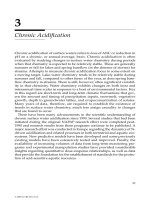Multicultural chapter 3
Bạn đang xem bản rút gọn của tài liệu. Xem và tải ngay bản đầy đủ của tài liệu tại đây (98.11 KB, 19 trang )
CHAPTER 3
MULTICULTURAL
COUNSELING
COMPETENCE FOR
MINORITY GROUP
COUNSELORS/THERAPISTS
The Politics of Interethnic
and Interracial Bias
Minority prejudice toward other minority groups occurs under
the umbrella of White racial superiority and supremacy.
There is historic justification for not “airing dirty laundry”
between groups.
However, people of color do hold prejudicial attitudes toward
one another and majority group members, and these can be
barriers to effective treatment.
Cultural Differences
in Values
Shared and non shared values held by groups of color
may lead to camaraderie or tension.
Example: Respect for elders is a value traditionally held
by Asian and African Americans.
Expression of this value, however, differs. While an
Asian American may avoid eye contact to show respect,
an African American may find this disrespectful.
Cultural Differences in
Communication Styles
Native Americans, Latinos, and Asian Americans tend to be
non confrontational and indirect.
African Americans tend to be direct, passionate, and
forthright.
Whites tend to favor a direct approach with direct eye
contact.
Issues Regarding
Ethnic Identity
Depending on therapists’ racial/ethnic identity, reactions to
members of their own race and other races will differ
considerably.
Ethnic minority therapists may have to acknowledge and
resolve identity issues since it may affect their reactions to a
client from the same ethnicity, or in dealing with White
clients.
The more divergent the cultural attitudes, beliefs, and
behaviors are between the client and counselor, the more
conflict there may be in the therapeutic relationship.
Challenges Associated With
Counseling White Clients
Situation One: Having the
Competency of the Therapist of Color
Challenged
Challenges Associated With
Counseling White Clients
Situation Two: Needing to Prove
Competence
Challenges Associated With
Counseling White Clients
Situation Three: Transferring
Animosity to White Clients
Challenges Associated With
Counseling White Clients
Situation Four: Unrealistically
Viewing the Therapist as a Super
Minority Therapist
Challenges Associated With
Counseling White Clients
Situation Five: Dealing With
Expressions of Racist
Attitudes/Beliefs/Behaviors
Challenges Associated With
Counseling Clients of Another
Minority Group or Own Group
Situation Six: Overidentification With
the Client
Challenges Associated With
Counseling Clients of Another
Minority Group or Own Group
Situation Seven: Encountering
Clashes in Cultural Values
Challenges Associated With
Counseling Clients of Another
Minority Group or Own Group
Situation Eight: Encountering Clashes
in Communication and Therapeutic
Styles
Challenges Associated With
Counseling Clients of Another
Minority Group or Own Group
Situation Nine: Receiving and
Expressing Racial Animosity
Challenges Associated With
Counseling Clients of Another
Minority Group or Own Group
Situation Ten: Dealing with the Stage
of Racial Identity of Counselors
and Clients
Implications for
Clinical Practice
People of color are not immune from having biases and prejudices.
Avoid the “who’s more oppressed” trap. All oppression is damaging and
serves to separate rather than unify.
Don’t let interethnic/interracial conflicts destroy intergroup unity.
Implications for
Clinical Practice
Not all bad things that happen to people of color are the results of racism.
While blaming the victim is detrimental to our psychological well-being, it
is equally destructive to attribute all negative events in our lives to racism.
Know that understanding your own worldview and how it may potentially
clash with that of clients of color is important.
Implications for Clinical
Practice
Realize that your communication style may impact the client. Being able to
anticipate your social impact on others and modifying it so as to relate better
to clients are very important.
It is important to realize that your awareness of who you are as a
racial/cultural being is paramount to working effectively with other clients
of color.
Be comfortable addressing topics like race, gender, and sexual orientation.
Implications for Clinical
Practice
White people can be valuable allies. The enemy is White supremacy, not
White Americans.
Don’t write off people’s racially insensitive remarks without a chance for
rectification.
We must form multicultural alliances.
Being bicultural or multicultural is not selling out. Being able to function in
White society is different from “acting White.”









